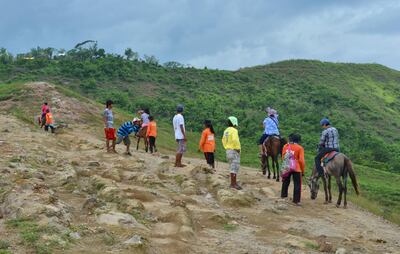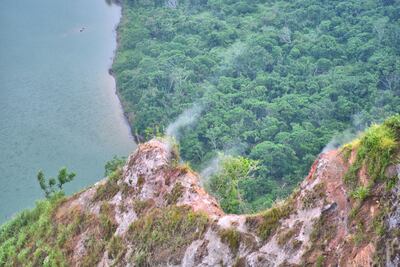It became one of the Philippines' top tourist attractions due to its gorgeous setting and notoriety as the world's smallest active volcano. Now, as ash spews from Taal volcano for the 10th consecutive day, this eruption is threatening lives, livelihoods and the future of the tourism industry in Tagaytay, 60 kilometres south of the Filipino capital, Manila.
Taal began erupting on January 12, affecting almost 500,000 people who live inside the 14km-radius danger zone. While there are not yet believed to have been any deaths directly caused by the eruption, seismologists have warned there is an imminent risk of a much larger and potentially deadly explosion. As a result, Philippines authorities have put in place a level four alert, the second-highest rating for a volcano.
Police have set up roadblocks on the perimeter of the danger zone, preventing vehicles from entering, while attempting to evacuate buildings housing residents within the hazardous area. The volcano is on an island within a lake, which is itself inside an island, all of which is part of a huge volcanic crater called the Taal caldera. At 311 metres tall, it is reputedly the world's smallest active volcano, and has erupted more than 30 times in the past 400 years, causing thousands of deaths.
But the volcano's last eruption was 43 years ago and, in the meantime, it has helped build a strong tourism industry in Tagaytay, the small city on the northern edge of Taal Lake, as well as on the volcanic island itself. An 80-minute drive from downtown Manila, a city of more than 13 million people, Tagaytay attracts a huge number of foreign and domestic tourists each year. Some Manila residents escape to this hilltop city to enjoy the fresher air, cooler climate and greater sense of space.
Many more tourists go to the city specifically to visit the Taal volcano. When I visited Tagaytay three years ago, the moment my bus from Manila stopped in the city, touts crowded around the alighting passengers, offering us volcano tours. Some of these packages were upmarket, involving chauffeured cars to Taal lake, private boats across to Volcano Island, catered food and organised activities on the island.
Most of them, like the one I chose, were no-frills. An autorickshaw drove me to the lake, where I walked down a rickety wooden jetty and joined other tourists in a small pump boat, a motorised version of the traditional Filipino outrigger vessel. During our 20-minute ride to the island, I chatted with the other passengers, all of whom were Filipinos on day trips from Manila. When I asked them if they thought visiting the volcano was safe, they shrugged. One man answered that it must not be dangerous given how many other tourists were flocking to the island.
At the island’s main pier, we were greeted by tour guides promoting their services, touts advertising horse rides to the rim of the volcano and locals offering homestay accommodation on the island. This latter group caught me by surprise. I had been unaware that, despite this island being home to a deadly volcano, it was also inhabited by more than 5,000 people, who live in several scattered villages.
The island's appeal to its residents is obvious. It is quiet and unspoilt, has rich volcanic soil perfect for farming, and boasts beguiling beauty thanks to its lush, green environment, the pristine waters of the lake, and the dramatic presence of the Taal volcano. All of this, combined with the 43-year lull in the volcano's activity, was enough to convince the villagers that the island was a fine home. Not to mention the employment opportunities associated with volcano tourism in a region plagued with widespread poverty.
During my day at the volcano, I met dozens of people directly employed in this industry. They include boat captains, guides, touts, birdwatching teachers and the staff that manned the tourism offices, snack stalls and restaurants near the main pier and at the volcano rim. For $20 (Dh73.5), tourists could hire a horse and a handler to head from the pier up to the rim. I hiked instead and, after a 40-minute ascent, arrived at the rim to be met by smiling ice cream sellers, photographers glad to take images for a fee, and people renting golf clubs with which to hit balls down into the crater.
As I watched Filipino men laughing while they tested their golf skills, children giggling between licks of their ice creams, and hugging couples posing for photos, I saw something that ruptured this atmosphere of frivolity. On the steep slope from the rim down into the crater, gases were rising out of the ground. This was a bracing reminder of the instability and hazardous nature of my environment.
That sight, combined with the strong chemical odour in the air, snapped me out of my relaxed, complacent state of mind. Later, as I made the return boat ride to Tagaytay, I looked back at the volcano and wondered how long it would be until it erupted again.
Now, the entire island is cloaked in thick layers of ash, which have destroyed crops not just there but also in many villages that surround the lake. Even if a larger eruption does not occur in the coming days or weeks, what has taken place here already has left hundreds of thousands of lives in limbo. It still remains unclear when residents of the danger zone will be able to safely return to their homes, but what is clear, is that it will be a long time before tourism returns to Taal volcano.
Company%C2%A0profile
%3Cp%3E%3Cstrong%3ECompany%20name%3A%20%3C%2Fstrong%3Eamana%3Cbr%3E%3Cstrong%3EStarted%3A%20%3C%2Fstrong%3E2010%3Cbr%3E%3Cstrong%3EFounders%3A%3C%2Fstrong%3E%20Karim%20Farra%20and%20Ziad%20Aboujeb%3Cbr%3E%3Cstrong%3EBased%3A%20%3C%2Fstrong%3EUAE%3Cbr%3E%3Cstrong%3ERegulator%3A%20%3C%2Fstrong%3EDFSA%3Cbr%3E%3Cstrong%3ESector%3A%20%3C%2Fstrong%3EFinancial%20services%3Cbr%3E%3Cstrong%3ECurrent%20number%20of%20staff%3A%20%3C%2Fstrong%3E85%3Cbr%3E%3Cstrong%3EInvestment%20stage%3A%20%3C%2Fstrong%3ESelf-funded%3Cbr%3E%3C%2Fp%3E%0A
GOODBYE%20JULIA
%3Cp%3E%3Cstrong%3EDirector%3A%20%3C%2Fstrong%3EMohamed%20Kordofani%3C%2Fp%3E%0A%3Cp%3E%3Cstrong%3EStarring%3A%20%3C%2Fstrong%3ESiran%20Riak%2C%20Eiman%20Yousif%2C%20Nazar%20Goma%3C%2Fp%3E%0A%3Cp%3E%3Cstrong%3ERating%3A%3C%2Fstrong%3E%205%2F5%3C%2Fp%3E%0A
Specs
Engine: 51.5kW electric motor
Range: 400km
Power: 134bhp
Torque: 175Nm
Price: From Dh98,800
Available: Now
Top investing tips for UAE residents in 2021
Build an emergency fund: Make sure you have enough cash to cover six months of expenses as a buffer against unexpected problems before you begin investing, advises Steve Cronin, the founder of DeadSimpleSaving.com.
Think long-term: When you invest, you need to have a long-term mindset, so don’t worry about momentary ups and downs in the stock market.
Invest worldwide: Diversify your investments globally, ideally by way of a global stock index fund.
Is your money tied up: Avoid anything where you cannot get your money back in full within a month at any time without any penalty.
Skip past the promises: “If an investment product is offering more than 10 per cent return per year, it is either extremely risky or a scam,” Mr Cronin says.
Choose plans with low fees: Make sure that any funds you buy do not charge more than 1 per cent in fees, Mr Cronin says. “If you invest by yourself, you can easily stay below this figure.” Managed funds and commissionable investments often come with higher fees.
Be sceptical about recommendations: If someone suggests an investment to you, ask if they stand to gain, advises Mr Cronin. “If they are receiving commission, they are unlikely to recommend an investment that’s best for you.”
Get financially independent: Mr Cronin advises UAE residents to pursue financial independence. Start with a Google search and improve your knowledge via expat investing websites or Facebook groups such as SimplyFI.
Jetour T1 specs
Engine: 2-litre turbocharged
Power: 254hp
Torque: 390Nm
Price: From Dh126,000
Available: Now
How%20to%20avoid%20getting%20scammed
%3Cul%3E%0A%3Cli%3ENever%20click%20on%20links%20provided%20via%20app%20or%20SMS%2C%20even%20if%20they%20seem%20to%20come%20from%20authorised%20senders%20at%20first%20glance%3C%2Fli%3E%0A%3Cli%3EAlways%20double-check%20the%20authenticity%20of%20websites%3C%2Fli%3E%0A%3Cli%3EEnable%20Two-Factor%20Authentication%20(2FA)%20for%20all%20your%20working%20and%20personal%20services%3C%2Fli%3E%0A%3Cli%3EOnly%20use%20official%20links%20published%20by%20the%20respective%20entity%3C%2Fli%3E%0A%3Cli%3EDouble-check%20the%20web%20addresses%20to%20reduce%20exposure%20to%20fake%20sites%20created%20with%20domain%20names%20containing%20spelling%20errors%3C%2Fli%3E%0A%3C%2Ful%3E%0A
Heather, the Totality
Matthew Weiner,
Canongate
SPECS
%3Cp%3E%3Cstrong%3EEngine%3A%3C%2Fstrong%3E%201.5-litre%204-cylinder%3Cbr%3E%3Cstrong%3EPower%3A%3C%2Fstrong%3E%20101hp%3Cbr%3E%3Cstrong%3ETorque%3A%3C%2Fstrong%3E%20135Nm%3Cbr%3E%3Cstrong%3ETransmission%3C%2Fstrong%3E%3A%20Six-speed%20auto%3Cbr%3E%3Cstrong%3EPrice%3A%3C%2Fstrong%3E%20From%20Dh79%2C900%3Cbr%3E%3Cstrong%3EOn%20sale%3A%3C%2Fstrong%3E%20Now%3C%2Fp%3E%0A
Why are asylum seekers being housed in hotels?
The number of asylum applications in the UK has reached a new record high, driven by those illegally entering the country in small boats crossing the English Channel.
A total of 111,084 people applied for asylum in the UK in the year to June 2025, the highest number for any 12-month period since current records began in 2001.
Asylum seekers and their families can be housed in temporary accommodation while their claim is assessed.
The Home Office provides the accommodation, meaning asylum seekers cannot choose where they live.
When there is not enough housing, the Home Office can move people to hotels or large sites like former military bases.
Squad for first two ODIs
Kohli (c), Rohit, Dhawan, Rayudu, Pandey, Dhoni (wk), Pant, Jadeja, Chahal, Kuldeep, Khaleel, Shami, Thakur, Rahul.
Key facilities
- Olympic-size swimming pool with a split bulkhead for multi-use configurations, including water polo and 50m/25m training lanes
- Premier League-standard football pitch
- 400m Olympic running track
- NBA-spec basketball court with auditorium
- 600-seat auditorium
- Spaces for historical and cultural exploration
- An elevated football field that doubles as a helipad
- Specialist robotics and science laboratories
- AR and VR-enabled learning centres
- Disruption Lab and Research Centre for developing entrepreneurial skills
UAE currency: the story behind the money in your pockets
More from Neighbourhood Watch:
Five films to watch
Castle in the Sky (1986)
Grave of the Fireflies (1988)
Only Yesterday (1991)
Pom Poki (1994)
The Tale of Princess Kaguya (2013)
Killing of Qassem Suleimani
What the law says
Micro-retirement is not a recognised concept or employment status under Federal Decree Law No. 33 of 2021 on the Regulation of Labour Relations (as amended) (UAE Labour Law). As such, it reflects a voluntary work-life balance practice, rather than a recognised legal employment category, according to Dilini Loku, senior associate for law firm Gateley Middle East.
“Some companies may offer formal sabbatical policies or career break programmes; however, beyond such arrangements, there is no automatic right or statutory entitlement to extended breaks,” she explains.
“Any leave taken beyond statutory entitlements, such as annual leave, is typically regarded as unpaid leave in accordance with Article 33 of the UAE Labour Law. While employees may legally take unpaid leave, such requests are subject to the employer’s discretion and require approval.”
If an employee resigns to pursue micro-retirement, the employment contract is terminated, and the employer is under no legal obligation to rehire the employee in the future unless specific contractual agreements are in place (such as return-to-work arrangements), which are generally uncommon, Ms Loku adds.
What is blockchain?
Blockchain is a form of distributed ledger technology, a digital system in which data is recorded across multiple places at the same time. Unlike traditional databases, DLTs have no central administrator or centralised data storage. They are transparent because the data is visible and, because they are automatically replicated and impossible to be tampered with, they are secure.
The main difference between blockchain and other forms of DLT is the way data is stored as ‘blocks’ – new transactions are added to the existing ‘chain’ of past transactions, hence the name ‘blockchain’. It is impossible to delete or modify information on the chain due to the replication of blocks across various locations.
Blockchain is mostly associated with cryptocurrency Bitcoin. Due to the inability to tamper with transactions, advocates say this makes the currency more secure and safer than traditional systems. It is maintained by a network of people referred to as ‘miners’, who receive rewards for solving complex mathematical equations that enable transactions to go through.
However, one of the major problems that has come to light has been the presence of illicit material buried in the Bitcoin blockchain, linking it to the dark web.
Other blockchain platforms can offer things like smart contracts, which are automatically implemented when specific conditions from all interested parties are reached, cutting the time involved and the risk of mistakes. Another use could be storing medical records, as patients can be confident their information cannot be changed. The technology can also be used in supply chains, voting and has the potential to used for storing property records.
Profile
Co-founders of the company: Vilhelm Hedberg and Ravi Bhusari
Launch year: In 2016 ekar launched and signed an agreement with Etihad Airways in Abu Dhabi. In January 2017 ekar launched in Dubai in a partnership with the RTA.
Number of employees: Over 50
Financing stage: Series B currently being finalised
Investors: Series A - Audacia Capital
Sector of operation: Transport




